Buckminsterfullerene
From Wikipedia, the free encyclopedia
This article is about the molecule. For other uses, see buckyball (disambiguation).
| Names | |||
|---|---|---|---|
| IUPAC name
(C60-Ih)[5,6]fullerene
| |||
| Other names
Buckyball; Fullerene-C60; [60]fullerene
| |||
| Identifiers | |||
| 5901022 | |||
| 99685-96-8 | |||
| ChEBI | CHEBI:33128 | ||
| ChemSpider | 110185 | ||
| Jmol-3D images | Image | ||
| PubChem | 123591 | ||
| Properties | |||
| C60 | |||
| Molar mass | 720.64 g·mol−1 | ||
| Appearance | Dark needle-like crystals | ||
| Density | 1.65 g/cm3 | ||
| Melting point | sublimates at ~ 600 °C (1,112 °F; 873 K)[1] | ||
| insoluble in water | |||
| Structure | |||
| Crystal structure | Face-centered cubic,cF1924 | ||
| Space group | Fm3m, No. 225 | ||
| Lattice constant | a = 1.4154 nm | ||
Except where noted otherwise, data is given for materials in their standard state (at 25 °C (77 °F), 100 kPa)
| |||
| | |||
| Infobox references | |||
| Part of a series of articles on |
| Nanomaterials |
|---|
| Fullerenes |
|
| Nanoparticles |
Buckminsterfullerene (or bucky-ball) is a spherical fullerene molecule with the formula C60. It has a cage-like fused-ring structure (truncated icosahedron) which resembles asoccer ball, made of twenty hexagons and twelve pentagons, with a carbon atom at each vertex of each polygon and a bond along each polygon edge.
It was first generated in 1985 by Harold Kroto, James R. Heath, Sean O'Brien, Robert Curl, and Richard Smalley at Rice University.[2] Kroto, Curl and Smalley were awarded the 1996Nobel Prize in Chemistry for their roles in the discovery of buckminsterfullerene and the related class of molecules, the fullerenes. The name is a reference to Buckminster Fuller, as C60 resembles his trademark geodesic domes. Buckminsterfullerene is the most common naturally occurring fullerene molecule, as it can be found in small quantities in soot.[3][4] Solid and gaseous forms of the molecule have been detected in deep space.[5]
Buckminsterfullerene is one of the largest objects to have been shown to exhibit wave–particle duality; as stated in the theory every object exhibits this behavior.[6][7] Its discovery led to the exploration of a new field of chemistry, involving the study of fullerenes.
Contents
[hide]Etymology[edit]
Buckminsterfullerene derives from the name of the noted futurist and inventor Buckminster Fuller. One of his designs of a geodesic dome structure bears great resemblance to C60; as a result, the discoverers of the allotrope named the newfound molecule after him. The general public, however, sometimes refers to buckminsterfullerene, and even Mr. Fuller's dome structure, as buckyballs.[8]
History[edit]
Main article: Fullerene
The structure associated with fullerenes was described by Leonardo da Vinci.[9] Albrecht Dürer also reproduced a similar icosahedron containing 12 pentagonal and 20 hexagonal faces but there are no clear documentations of this.[10][11]
Discovery[edit]
Theoretical predictions of buckyball molecules appeared in the late 1960s – early 1970s,[12][13] but they went largely unnoticed. In the early 1970s, the chemistry of unsaturated carbon configurations was studied by a group at the University of Sussex, led by Harry Kroto and David Walton. In the 1980s a technique was developed by Richard Smalley and Bob Curl at Rice University, Texas to isolate these substances. They used laser vaporization of a suitable target to produce clusters of atoms. Kroto realized that by using a graphite target,[14] any carbon chains formed could be studied. Another interesting fact is that, at the same time, astrophysicists were working along with spectroscopists to study infrared emissions from giant red carbon stars.[11][15][16] Smalley and team were able to use a laser vaporization technique to create carbon clusters which could potentially emit infrared at the same wavelength as had been emitted by the red carbon star.[11][17] Hence, the inspiration came to Smalley and team to use the laser technique on graphite to create the first fullerene molecule.
C60 was discovered in 1985 by Robert Curl, Harold Kroto and Richard Smalley. Using laser evaporation of graphite they found Cn clusters (where n>20 and even) of which the most common were C60 and C70. A solid rotating graphite disk was used as the surface from which carbon was vaporized using a laser beam creating hot plasma that was then passed through a stream of high-density helium gas.[18] The carbon species were subsequently cooled and ionized resulting in the formation of clusters. Clusters ranged in molecular masses but Kroto and Smalley found predominance in a C60 cluster that could be enhanced further by letting the plasma react longer.[3, 6] They also discovered that the C60 molecule formed a cage-like structure, a regular truncated icosahedron.[11][18]
For this discovery they were awarded the 1996 Nobel Prize in Chemistry. The discovery of buckyballs was surprising, as the scientists aimed the experiment at producing carbon plasmas to replicate and characterize unidentified interstellar matter. Mass spectrometryanalysis of the product indicated the formation of spheroidal carbon molecules.[12]
The experimental evidence, a strong peak at 720 atomic mass units, indicated that a carbon molecule with 60 carbon atoms was forming, but provided no structural information. The research group concluded after reactivity experiments, that the most likely structure was a spheroidal molecule. The idea was quickly rationalized as the basis of an icosahedral symmetry closed cage structure. Kroto mentioned geodesic dome structures of the noted futurist and inventor Buckminster Fuller as influences in the naming of this particular substance as buckminsterfullerene.[12]
Further developments[edit]
The versatility of fullerene molecules has led to a large amount of research exploring their properties. One interesting property is fullerene's large-capacity internal spaces. Atoms of different elements may be placed inside the molecular cage formed by the carbon atoms, producing a shrink-wrapped version of these elements.[19]
Beam-experiments conducted between 1985 and 1990 provided more evidence for the stability of C60 while supporting the closed-cage structural theory and predicting some of the bulk properties such a molecule would have. Around this time, intense theoretical group theory activity also predicted that C60 should have only four IR-active vibrational bands, on account of its icosahedral symmetry.[20]
In 1989 physicists Wolfgang Krätschmer and Donald R. Huffman observed unusual optical absorptions in thin carbon films produced by arc-processed graphite rods. Among other features, the IR spectra showed four discrete bands in close agreement to those proposed for C60. A paper published by the group in 1990 followed on from their thin film experiments, and detailed the extraction of a benzene soluble material from the arc-processed graphite. This extract had crystal and X-ray analysis consistent with arrays of spherical C60 molecules, approximately 0.7 nm in diameter.[20]
In 2012 a toxicity study by Tarek Baati and Fathi Moussa from the University of Paris, showed that C60 dissolved in Olive Oil and provided to rodents was not toxic.[21] In a video interview with Professor Fathi Moussa regarding the study, further information was provided regarding the toxicity study, and the method of action that could have caused the rodents intake of C60 Olive Oil providing an increase of lifespan by 90% over controls. [22]
Synthesis[edit]
In 1990, W. Krätschmer and D. R. Huffman developed a simple and efficient method of producing fullerenes in gram and even kilogram amounts, which has boosted the fullerene research. In this technique, carbon soot is produced from two high-purity graphite electrodes by igniting an arc discharge between them in an inert atmosphere (helium gas). Alternatively, soot is produced by laser ablation of graphite or pyrolysis of aromatic hydrocarbons. Fullerenes are extracted from the soot using a multistep procedure. First, the soot is dissolved in appropriate organic solvents. This step yields a solution containing up to 75% of C60, as well as other fullerenes. These fractions are separated using chromatography.[23] Generally, the fullerenes are dissolved in hydrocarbon or halogenated hydrocarbon and separated using alumina columns.[24]
Properties[edit]
Molecule[edit]
The structure of a buckminsterfullerene is a truncated icosahedron with 60 vertices and 32 faces (20 hexagons and 12 pentagons where no pentagons share a vertex) with a carbon atom at the vertices of each polygon and a bond along each polygon edge. The van der Waals diameter of a C
60 molecule is about 1.01 nanometers (nm). The nucleus to nucleus diameter of a C
60 molecule is about 0.71 nm. The C
60 molecule has two bond lengths. The 6:6 ring bonds (between two hexagons) can be considered "double bonds" and are shorter than the 6:5 bonds (between a hexagon and a pentagon). Its average bond length is 0.14 nm. Each carbon atom in the structure is bonded covalently with 3 others.[25]
60 molecule is about 1.01 nanometers (nm). The nucleus to nucleus diameter of a C
60 molecule is about 0.71 nm. The C
60 molecule has two bond lengths. The 6:6 ring bonds (between two hexagons) can be considered "double bonds" and are shorter than the 6:5 bonds (between a hexagon and a pentagon). Its average bond length is 0.14 nm. Each carbon atom in the structure is bonded covalently with 3 others.[25]
The C
60 molecule is extremely stable,[26] withstanding high temperatures and high pressures. The exposed surface of the structure can selectively react with other species while maintaining the spherical geometry.[27] Atoms and small molecules can be trapped within the molecule without reacting.
60 molecule is extremely stable,[26] withstanding high temperatures and high pressures. The exposed surface of the structure can selectively react with other species while maintaining the spherical geometry.[27] Atoms and small molecules can be trapped within the molecule without reacting.
C
60 undergoes six reversible, one-electron reductions to C6−
60, but oxidation is irreversible. The first reduction needs ~1.0 V (Fc/Fc+), showing that C60 is a moderately effective electron acceptor. C
60 tends to avoid having double bonds in the pentagonal rings, which makes electron delocalization poor, and results in C
60 not being not "superaromatic". C60 behaves very much like an electron deficientalkene and readily reacts with electron rich species.[20]
60 undergoes six reversible, one-electron reductions to C6−
60, but oxidation is irreversible. The first reduction needs ~1.0 V (Fc/Fc+), showing that C60 is a moderately effective electron acceptor. C
60 tends to avoid having double bonds in the pentagonal rings, which makes electron delocalization poor, and results in C
60 not being not "superaromatic". C60 behaves very much like an electron deficientalkene and readily reacts with electron rich species.[20]
A carbon atom in the C
60 molecule can be substituted by a nitrogen or boron atom yielding a C
59N or C59B respectively.[28]
60 molecule can be substituted by a nitrogen or boron atom yielding a C
59N or C59B respectively.[28]
| Centered by | Vertex | Edge 5–6 | Edge 6-6 | Face Hexagon | Face Pentagon |
|---|---|---|---|---|---|
| Image |  | 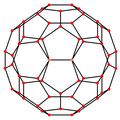 | 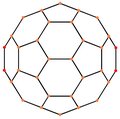 | 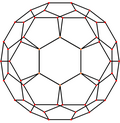 |  |
| Projective symmetry | [2] | [2] | [2] | [6] | [10] |
Solution[edit]
| Solvent | Solubility (mg/mL) |
|---|---|
| 1-chloronaphthalene | 51 |
| 1-methylnaphthalene | 33 |
| 1,2-dichlorobenzene | 24 |
| 1,2,4-trimethylbenzene | 18 |
| tetrahydronaphthalene | 16 |
| carbon disulfide | 8 |
| 1,2,3-tribromopropane | 8 |
| xylene | 5 |
| bromoform | 5 |
| cumene | 4 |
| toluene | 3 |
| benzene | 1.5 |
| carbon tetrachloride | 0.447 |
| chloroform | 0.25 |
| n-hexane | 0.046 |
| cyclohexane | 0.035 |
| tetrahydrofuran | 0.006 |
| acetonitrile | 0.004 |
| methanol | 0.00004 |
| water | 1.3×10−11 |
| pentane | 0.004 |
| octane | 0.025 |
| isooctane | 0.026 |
| decane | 0.070 |
| dodecane | 0.091 |
| tetradecane | 0.126 |
| dioxane | 0.0041 |
| mesitylene | 0.997 |
| dichloromethane | 0.254 |
Fullerenes are sparingly soluble in aromatic solvents such as toluene and carbon disulfide, but insoluble in water. Solutions of pure C60 have a deep purple color which leaves a brown residue upon evaporation. The reason for this color change is the relatively narrow energy width of the band of molecular levels responsible for green light absorption by individual C60 molecules. Thus individual molecules transmit some blue and red light resulting in a purple color. Upon drying, intermolecular interaction results in the overlap and broadening of the energy bands, thereby eliminating the blue light transmittance and causing the purple to brown color change.[32]
C
60 crystallises with some solvents in the lattice ("solvates"). For example, crystallization of C60 in benzenesolution yields triclinic crystals with the formula C60·4C6H6. Like other solvates, this one readily releases benzene to give the usual fcc C60. Millimeter-sized crystals of C60 andC
70 can be grown from solution both for solvates and for pure fullerenes.[33][34]
60 crystallises with some solvents in the lattice ("solvates"). For example, crystallization of C60 in benzenesolution yields triclinic crystals with the formula C60·4C6H6. Like other solvates, this one readily releases benzene to give the usual fcc C60. Millimeter-sized crystals of C60 andC
70 can be grown from solution both for solvates and for pure fullerenes.[33][34]
Solid[edit]
In solid buckminsterfullerene, the molecules C60 stick together via the van der Waals forces in the fcc motif. At low temperatures the individual molecules are locked against rotation. Upon heating, they start rotating at about −20 °C. This results in a first-order phase transition to a face-centered cubic (fcc) structure and a small, yet abrupt increase in the lattice constant from 1.411 to 1.4154 nm.[35]
C
60 solid is as soft as graphite, but when compressed to less than 70% of its volume it transforms into a superhardform of diamond (see aggregated diamond nanorod). C
60films and solution have strong non-linear optical properties; in particular, their optical absorption increases with light intensity (saturable absorption).
60 solid is as soft as graphite, but when compressed to less than 70% of its volume it transforms into a superhardform of diamond (see aggregated diamond nanorod). C
60films and solution have strong non-linear optical properties; in particular, their optical absorption increases with light intensity (saturable absorption).
C
60 forms a brownish solid with an optical absorption threshold at ~1.6 eV.[36] It is an n-type semiconductor with a low activation energy of 0.1–0.3 eV; this conductivity is attributed to intrinsic or oxygen-related defects.[37] Fcc C60 contains voids at its octahedral and tetrahedral sites which are sufficient large (0.6 and 0.2 nm respectively) to accommodate impurity atoms. When alkali metals are doped into these voids, C60 converts from a semiconductor into a conductor or even superconductor.[35][38]
60 forms a brownish solid with an optical absorption threshold at ~1.6 eV.[36] It is an n-type semiconductor with a low activation energy of 0.1–0.3 eV; this conductivity is attributed to intrinsic or oxygen-related defects.[37] Fcc C60 contains voids at its octahedral and tetrahedral sites which are sufficient large (0.6 and 0.2 nm respectively) to accommodate impurity atoms. When alkali metals are doped into these voids, C60 converts from a semiconductor into a conductor or even superconductor.[35][38]
Band structure and superconductivity[edit]
In 1991, Haddon et al.[39] found that intercalation of alkali-metal atoms in solid C60 leads to metallic behavior.[40] In 1991, it was revealed that potassium-doped C60 becomessuperconducting at 18 K.[41] This was the highest transition temperature for a molecular superconductor. Since then, superconductivity has been reported in fullerene doped with various other alkali metals.[42][43] It has been shown that the superconducting transition temperature in alkaline-metal-doped fullerene increases with the unit-cell volume V.[44][45] As caesium forms the largest alkali ion, caesium-doped fullerene is an important material in this family. Recently, superconductivity at 38 K has been reported in bulk Cs3C60,[46] but only under applied pressure. The highest superconducting transition temperature of 33 K at ambient pressure is reported for Cs2RbC60.[47]
The increase of transition temperature with the unit-cell volume had been believed to be evidence for the BCS mechanism of C60 solid superconductivity, because inter C60 separation can be related to an increase in the density of states on the Fermi level, N(εF). Therefore, there have been many efforts to increase the interfullerene separation, in particular, intercalating neutral molecules into the A3C60 lattice to increase the interfullerene spacing while the valence of C60 is kept unchanged. However, this ammoniation technique has revealed a new aspect of fullerene intercalation compounds: the Mott transition and the correlation between the orientation/orbital order of C60 molecules and the magnetic structure.[48]
The C60 molecules compose a solid of weakly bound molecules. The fullerites are therefore molecular solids, in which the molecular properties still survive. The discrete levels of a free C60molecule are only weakly broadened in the solid, which leads to a set of essentially nonoverlapping bands with a narrow width of about 0.5 eV.[40] For an undoped C60 solid, the 5-fold hu band is the HOMO level, and the 3-fold t1u band is the empty LUMO level, and this system is a band insulator. But when the C60 solid is doped with metal atoms, the metal atoms give electrons to the t1u band or the upper 3-fold t1g band.[49] This partial electron occupation of the band may lead to metallic behavior. However, A4C60 is an insulator, although the t1u band is only partially filled and it should be a metal according to band theory.[50] This unpredicted behavior may be explained by the Jahn-Teller effect, where spontaneous deformations of high-symmetry molecules induce the splitting of degenerate levels to gain the electronic energy. The Jahn-Teller type electron-phonon interaction is strong enough in C60 solids to destroy the band picture for particular valence states.[48]
A narrow band or strongly correlated electronic system and degenerated ground states are important points to understand in explaining superconductivity in fullerene solids. When the inter-electron repulsion U is greater than the bandwidth, an insulating localized electron ground state is produced in the simple Mott-Hubbard model. This explains the absence of superconductivity at ambient pressure in caesium-doped C60 solids.[46] Electron-correlation-driven localization of the t1u electrons exceeds the critical value, leading to the Mott insulator. The application of high pressure decreases the interfullerene spacing, therefore caesium-doped C60 solids turn to metallic and superconducting.
A fully developed theory of C60 solids superconductivity is still lacking, but it has been widely accepted that strong electronic correlations and the Jahn-Teller electron-phonon coupling[51] produce local electron-pairings that show a high transition temperature close to the insulator-metal transition.[52]
Chemical reactions and properties[edit]
Hydrated fullerene (HyFn)[edit]
Hydrated fullerene C60HyFn is a stable, highly hydrophilic, supra-molecular complex consisting of С60 fullerene molecule enclosed into the first hydrated shell that contains 24 water molecules: C60@(H2O)24. This hydrated shell is formed as a result of donor-acceptor interaction betweenlone-electron pairs of oxygen, water molecules and electron-acceptor centers on the fullerene surface. Meanwhile, the water molecules which are oriented close to the fullerene surface are interconnected by a three-dimensional network of hydrogen bonds. The size of C60HyFn is 1.6–1.8 nm. The maximal concentration of С60 in the form of C60HyFn achieved by 2010 is 4 mg/mL.[53] [54][55][56]
Hydrogenation[edit]
C60 exhibits a small degree of aromatic character, but it still reflects localized double and single C-C bond characters. Therefore C60 can undergo addition with hydrogen to give polyhydrofullerenes. C60 also undergoes Birch reduction. For example, C60 reacts with lithium in liquid ammonia, followed by tert-butanol to give a mixture of polyhydrofullerenes such as C60H18, C60H32, C60H36, with C60H32 being the dominating product. This mixture of polyhydrofullerenes can be re-oxidized by 2,3-Dichloro-5,6-dicyano-1,4-benzoquinone to give C60 again.
Selective hydrogenation method exists. Reaction of C60 with 9,9',10,10'-dihydroanthracene under the same conditions, depending on the time of reaction, gives C60H32 and C60H18 respectively and selectively.[57]
C60 can be hydrogenated,[58] suggesting that a modified buckminsterfullerene called organometallic buckyballs (OBBs) could become a vehicle for "high density, room temperature, ambient pressure storage of hydrogen". These OBBs are created by binding atoms of atransition metal (TM) to C60 or C48B12 and then binding many hydrogen atoms to this TM atom, dispersing them evenly throughout the inside of the organometallic buckyball. The study found that the theoretical amount of H2 that can be retrieved from the OBB at ambient pressure approaches 9 wt %, a mass fraction that has been designated as optimal for hydrogen fuel by the U.S. Department of Energy.
Halogenation[edit]
Fluorine atoms are small enough for a 1,2-addition, while Cl2 and Br2 add to remote C atoms due to steric factors. For example, in C60Br8and C60Br24, the Br atoms are in 1,3- or 1,4-positions with respect to each other.
Under various conditions a vast number of halogenated derivatives of C60 can be produced, some with extraordinary selectivity on one or two isomers over the other possible ones.
Addition of fluorine and chlorine usually results in a flattening of the C60 framework into a drum-shaped molecule.[57]
Addition of oxygen atoms[edit]
Solutions of C60 can be oxygenated to the epoxide C60O. Ozonation of C60 in 1,2-xylene at 257K gives an intermediate ozonide C60O3, which can be decomposed into 2 forms of C60O. Decomposition of C60O3 at 296K gives the epoxide, but photolysis gives a product in which the O atom bridges a 5,6-edige.[57]
Cycloadditions[edit]
The Diels-Alder reaction is commonly employed to functionalize C60. Reaction of C60 with appropriate substituted diene gives the corresponding adduct.
The Diels-Alder reaction between C60 and 3,6-diaryl-1,2,4,5-tetrazines affords C62. The C62 has the structure in which a four-membered ring is surrounded by four six-membered rings.
The C60 molecules can also be coupled through a [2+2] cycloaddition, giving the dumbbell-shaped compound C120. The coupling is achieved by high-speed vibrating milling of C60 with a catalytic amount of KCN. The reaction is reversible as C120 dissociates back to two C60 molecules when heated at 450 K (177 °C; 350 °F). Under high pressure and temperature, repeated [2+2] cycloaddtion between C60 results in a polymerized fullerene chains and networks. These polymers remain stable at ambient pressure and temperature once formed, and have remarkably interesting electronic and magnetic properties, such as being ferromagnetic above room temperature.[57]
Free radical reactions[edit]
Reactions of C60 with free radicals readily occur. When C60 is mixed with a disulfide RSSR, the radical C60SR• forms spontaneously upon irradiation of the mixture.
Stability of the radical species C60Y• depends largely on steric factors of Y. When tert-butyl halide is photolyzed and allowed to react with C60, a reversible inter-cage C-C bond is formed:[57]
Cyclopropanation (Bingel reaction)[edit]
Cyclopropanation (Bingel reaction) is another common method for functionalizing C60. Cyclopropanation of C60 mostly occurs at the junction of 2 hexagons due to steric factors.
The first cyclopropanation was carried out by treating the β-bromomalonate with C60 in the presence of a base. Cyclopropanation also occur readily with diazomethanes. For example, diphenyldiazomethane reacts readily with C60 to give the compound C61Ph2.[57] Phenyl-C61-butyric acid methyl ester derivative prepared through cyclopropanation has been studied for use in organic solar cells.
Redox reactions – C60 anions and cations[edit]
The LUMO in C60 is triply degenerate, with the HOMO-LUMO separation relatively small. This small gap suggests that reduction of C60should occur at mild potentials leading to fulleride anions, [C60]n− (n = 1–6). The midpoint potentials of 1-electron reduction of buckminsterfullerene and its anions is given in the table below:
| Reduction potential of C60 at 213K | |
|---|---|
| Half-reaction | E° (V) |
| C60 + e− ⇌ C− 60 | −0.169 |
| C− 60 + e− ⇌ C2− 60 | −0.599 |
| C2− 60 + e− ⇌ C3− 60 | −1.129 |
| C3− 60 + e− ⇌ C4− 60 | −1.579 |
| C4− 60 + e− ⇌ C5− 60 | −2.069 |
| C5− 60 + e− ⇌ C6− 60 | −2.479 |
C60 forms a variety of charge-transfer complexes, for example with tetrakis(dimethylamino)ethylene:
- C60 + C2(NMe2)4 → [C2(NMe2)4]+[C60]−
This salt exhibits ferromagnetism at 16K.
The paramagnetic fulleride ion [C60]2− has been isolated as the [K(crypt-222)]+ salt. It is synthesized by treating C60 with metallicpotassium in the presence of 2.2.2-Cryptand. The most common fulleride ion, however, is [C60]3−. Alkali metal salts of this trianion aresuperconducting. In M3C60 (M = Na, K, Rb), the M+ ions occupy the interstitial holes in a lattice composed of ccp lattice composed of nearly spherical C60 anions. In Cs3C60, the cages are arranged in a bcc lattice.
| Critical temperatures (Tc) of the fulleride salts M3C60 | |
|---|---|
| Salt | Tc (K) |
| Na3C60 | (non-superconductive) |
| K3C60 | 18 |
| Rb3C60 | 28 |
| Cs3C60 | 40 |
C60 oxidizes with difficulty. Three reversible oxidation processes have been observed by using cyclic voltammetry with ultra-drymethylene chloride and a supporting electrolyte with extremely high oxidation resistance and low nucleophilicity, such as [nBu4N] [AsF6].[57]
| Reduction potentials of C60 oxidation at low temperatures | |
|---|---|
| Half-reaction | E◌ (V) |
| C60 ⇌ C+ 60 | +1.27 |
| C+ 60 ⇌ C2+ 60 | +1.71 |
| C2+ 60 ⇌ C3+ 60 | +2.14 |
Which the [C60]2+ ion is very unstable, and the third process can be studied only at low temperatures.
The redox potentials of C60 can be modified supramolecularly. A dibenzo-18-crown-6 derivative of C60 has been made, featuring a voltage sensor device, with the reversible binding of K+ ion causing an anodic shift of 90mV of the first C60 reduction.
Metal complexes[edit]
Main article: Fullerene ligand
C60 forms complexes akin to the more common alkenes. Complexes have been reported molybdenum, tungsten, platinum, palladium,iridium, and titanium. The pentacarbonyl species are produced by photochemical reactions.
- M(CO)6 + C60 → M(η2-C60)(CO)5 + CO (M = Mo, W)
In the case of platinum complex, the labile ethylene ligand is the leaving group in a thermal reaction:
- Pt(η2-C2H4)(PPh3)2 + C60 → Pt(η2-C60)(PPh3)2 + C2H4
Titanocene complexes have also been reported:
- (η5-Cp)2Ti(η2-(CH3)3SiC≡CSi(CH3)3) + C60 → (η5-Cp)2Ti(η2-C60) + (CH3)3SiC≡CSi(CH3)3
Coordinatively unsaturated precursors, such as Vaska's complex, for adducts with C60:
- trans-Ir(CO)Cl(PPh3)2 + C60 → Ir(CO)Cl(η2-C60)(PPh3)2
One such iridium complex, [Ir(η2-C60)(CO)Cl(Ph2CH2C6H4OCH2Ph)2] has been prepared where the metal center projects two electron-rich 'arms' that embrace the C60 guest.[59]
Endohedral fullerenes[edit]
Main articles: Endohedral fullerene and Endohedral hydrogen fullerene
Metal atoms or certain small molecules such as H2 and noble gas can be encapsulated inside the C60 cage. These endohedral fullerenes are usually synthesized by doping in the metal atoms in an arc reactor or by laser evaporation. These methods gives low yields of endohedral fullerenes, and a better method involves the opening of the cage, packing in the atoms or molecules, and closing the opening using certain organic reactions. This method, however, is still immature and only a few species have been synthesized this way.[60]
Endohedral fullerenes show distinct and intriguing chemical properties that can be completely different from the encapsulated atom or molecule, as well as the fullerene itself. The encapsulated atoms have been shown to perform circular motions inside the C60 cage, and its motion has been followed by using NMR spectroscopy.[59]
Applications[edit]
No application of C60 has been commercialized. In the medical field, elements such as helium (that can be detected in minute quantities) can be used as chemical tracers in impregnated buckyballs. Buckminsterfullerene also inhibits the HIV virus. In particular, C60 inhibits a key enzyme in the human immunodeficiency virus known as HIV-1 protease; this could inhibit reproduction of the HIV virus in immune cells.[citation needed]
Water-soluble derivatives of C60 were discovered to exert an inhibition on the three isoforms of nitric oxide synthase, with slightly different potencies.[61]
The optical absorption properties of C60 match solar spectrum in a way that suggests that C60-based films could be useful for photovoltaic applications. Because of its high electronic affinity [62] it is one of the most common electron acceptor used in donor/acceptor based solar cells. Conversion efficiencies up to 5.7% have been reported in C60-polymer cells.[63]
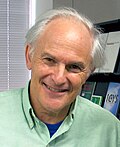



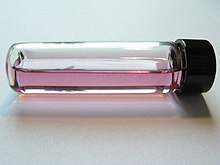
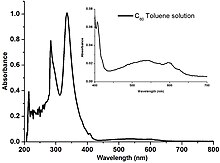
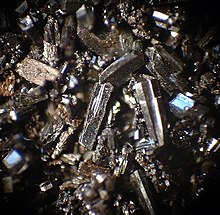




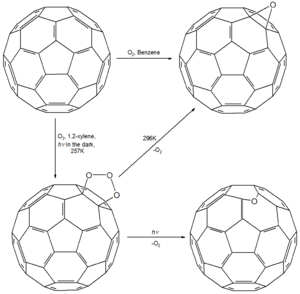



Comments
Post a Comment